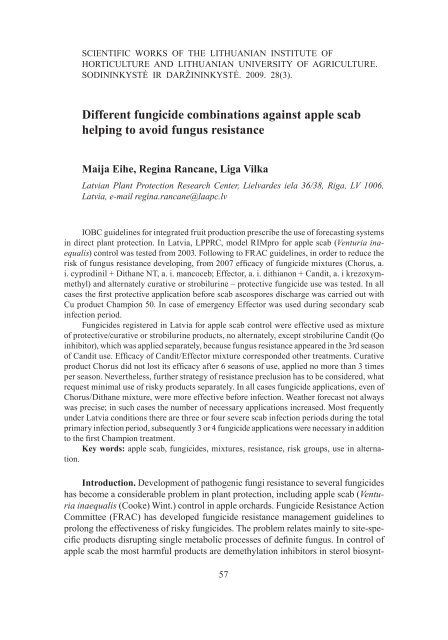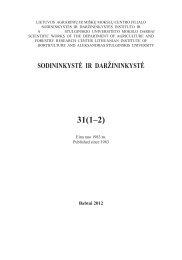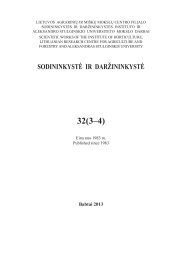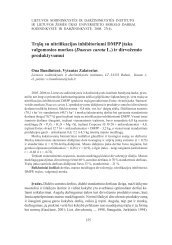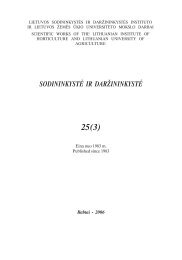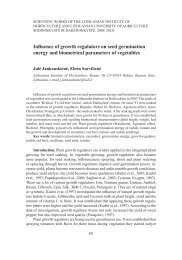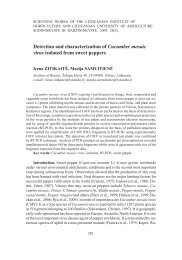Different fungicide combinations against apple scab - scientific works
Different fungicide combinations against apple scab - scientific works
Different fungicide combinations against apple scab - scientific works
Create successful ePaper yourself
Turn your PDF publications into a flip-book with our unique Google optimized e-Paper software.
SCIENTIFIC WORKS OF THE LITHUANIAN INSTITUTE OF<br />
HORTICULTURE AND LITHUANIAN UNIVERSITY OF AGRICULTURE.<br />
SODININKYSTĖ IR DARŽININKYSTĖ. 2009. 28(3).<br />
<strong>Different</strong> <strong>fungicide</strong> <strong>combinations</strong> <strong>against</strong> <strong>apple</strong> <strong>scab</strong><br />
helping to avoid fungus resistance<br />
Maija Eihe, Regina Rancane, Liga Vilka<br />
Latvian Plant Protection Research Center, Lielvardes iela 36/38, Riga, LV 1006,<br />
Latvia, e-mail regina.rancane@laapc.lv<br />
IOBC guidelines for integrated fruit production prescribe the use of forecasting systems<br />
in direct plant protection. In Latvia, LPPRC, model RIMpro for <strong>apple</strong> <strong>scab</strong> (Venturia inaequalis)<br />
control was tested from 2003. Following to FRAC guidelines, in order to reduce the<br />
risk of fungus resistance developing, from 2007 efficacy of <strong>fungicide</strong> mixtures (Chorus, a.<br />
i. cyprodinil + Dithane NT, a. i. mancoceb; Effector, a. i. dithianon + Candit, a. i krezoxymmethyl)<br />
and alternately curative or strobilurine – protective <strong>fungicide</strong> use was tested. In all<br />
cases the first protective application before <strong>scab</strong> ascospores discharge was carried out with<br />
Cu product Champion 50. In case of emergency Effector was used during secondary <strong>scab</strong><br />
infection period.<br />
Fungicides registered in Latvia for <strong>apple</strong> <strong>scab</strong> control were effective used as mixture<br />
of protective/curative or strobilurine products, no alternately, except strobilurine Candit (Qo<br />
inhibitor), which was applied separately, because fungus resistance appeared in the 3rd season<br />
of Candit use. Efficacy of Candit/Effector mixture corresponded other treatments. Curative<br />
product Chorus did not lost its efficacy after 6 seasons of use, applied no more than 3 times<br />
per season. Nevertheless, further strategy of resistance preclusion has to be considered, what<br />
request minimal use of risky products separately. In all cases <strong>fungicide</strong> applications, even of<br />
Chorus/Dithane mixture, were more effective before infection. Weather forecast not always<br />
was precise; in such cases the number of necessary applications increased. Most frequently<br />
under Latvia conditions there are three or four severe <strong>scab</strong> infection periods during the total<br />
primary infection period, subsequently 3 or 4 <strong>fungicide</strong> applications were necessary in addition<br />
to the first Champion treatment.<br />
Key words: <strong>apple</strong> <strong>scab</strong>, <strong>fungicide</strong>s, mixtures, resistance, risk groups, use in alternation.<br />
Introduction. Development of pathogenic fungi resistance to several <strong>fungicide</strong>s<br />
has become a considerable problem in plant protection, including <strong>apple</strong> <strong>scab</strong> (Venturia<br />
inaequalis (Cooke) Wint.) control in <strong>apple</strong> orchards. Fungicide Resistance Action<br />
Committee (FRAC) has developed <strong>fungicide</strong> resistance management guidelines to<br />
prolong the effectiveness of risky <strong>fungicide</strong>s. The problem relates mainly to site-specific<br />
products disrupting single metabolic processes of definite fungus. In control of<br />
<strong>apple</strong> <strong>scab</strong> the most harmful products are demethylation inhibitors in sterol biosynt-<br />
57
hesis (SBI, DMI) (Scheinpflug, 1988; Szkolnik, 1981), strobilurins – quinone outside<br />
inhibitors (QoI) (Broniarek-Niemec, Bielenin, 2008; Turechek, Köller, 2004),<br />
and anilinopirimidines (Dux et al., 2004; Köller, Wilcox et al., 2005). According<br />
to anti-resistance management strategies, risky products are used in mixtures or in<br />
alternation with protective low risk <strong>fungicide</strong>s, e. g. mancozeb, also they are used in<br />
sufficiently high dosages, only when justified and mainly protectively (Köller, Parker<br />
et al., 2005; Köller, Wilcox, 2001, Staub, 1991). FRAC is developed <strong>fungicide</strong> Code<br />
List according to resistance risk level (FRAC Code List, 2007).<br />
In Latvia traditionally minimal amount of pesticides was used on horticultural<br />
crops. During the last decades, <strong>apple</strong> plantations quickly enlarged and growers intensified<br />
pesticide use to save yield quality. The choice of <strong>fungicide</strong>s is poor. Therefore,<br />
recommendations of suitable anti-resistance plant protection strategy are important.<br />
From 2003 <strong>apple</strong> <strong>scab</strong> warning model RIMpro was tested in Latvian Plant<br />
Protection Research Centre for adoption under conditions of Latvia. In the first years<br />
only curative <strong>fungicide</strong> Chorus 75 WG (a. i. cyprodinil, anilino pyrimidine group)<br />
was used shortly after RIMpro warning about risky infection. During the last years,<br />
FRAC (Fungicide Resistance Action Committee) baselines and recommendations about<br />
strategies to prevent fungus resistance were considered: use of <strong>fungicide</strong> mixtures with<br />
different modes of action or their use in alternation, as much as possible not several<br />
times in turn, use of protective products before forecasted infection as well as all applications<br />
before infection. There was little experience of <strong>fungicide</strong> mixtures efficacy<br />
in <strong>apple</strong> <strong>scab</strong> control in Latvia up till now. In 2007 and 2008 field trial was arranged<br />
to compare efficacy of different <strong>fungicide</strong> <strong>combinations</strong> in <strong>scab</strong> control taking into<br />
account RIMpro indices of risky infection.<br />
Object, methods and conditions. Field trial was carried out in peasant farm<br />
“Kalnanoras”, Ikskile, Ogre district in 2007–2008. There was investigated <strong>apple</strong> cultivar<br />
‘Spartan’, on dwarf rootstock B 396, planted in 2000. Trial plot: 6 trees, 4 replicates<br />
in randomized blocks. Untreated control plots located out of blocks. In the trial<br />
the mostly used <strong>fungicide</strong>s registered for <strong>apple</strong> orchards in Latvia and recommended<br />
mixtures were employed (Table 1).<br />
Table 1. Fungicides used in trial<br />
1 lentelė. Bandyme panaudoti fungicidai<br />
Trade name<br />
Prekinis<br />
pavadinimas<br />
Active<br />
ingredient<br />
Aktyvi sudedamoji<br />
dalis<br />
g kg -1<br />
Chemical<br />
group<br />
Cheminė<br />
grupė<br />
58<br />
Mode of action<br />
Poveikio būdas<br />
FRAC Resistance<br />
code risk<br />
FRAC Atsparumo<br />
kodas pavojus<br />
1 2 3 4 5 6 7<br />
Champion 50 SP Copper hydroxide 770 Copper Protecting<br />
M1 Low<br />
Vario hidroksidas Varis Apsauginis<br />
Mažas<br />
Dithane NT WG Mancozeb 750 Dithio- Protecting<br />
M3 Low<br />
carbamate<br />
Apsauginis<br />
Mažas<br />
Effector WG Dithianone 700 Quinone Protecting<br />
M9 Low<br />
Apsauginis<br />
Mažas
Table 1 continued<br />
1 lentelės tęsinys<br />
1 2 3 4 5 6 7<br />
Chorus 75 WG Cyprodinil 750 Anilinopirimidine<br />
Candit WG Kresoxim-metyl 500 Strobilurin,<br />
QoI<br />
59<br />
Systemic, post-infection<br />
Sisteminis, poinfekcinis<br />
Locally systemic,<br />
mostly protecting<br />
Vietiškai sisteminis,<br />
daugiausia apsauginis<br />
9 Medium<br />
Vidutinis<br />
11 High<br />
Didelis<br />
These are mostly all <strong>fungicide</strong>s registered in Latvia for <strong>apple</strong> <strong>scab</strong> control with<br />
exception of Score 250 (a. i. difenoconazole, SBI, DMI), <strong>against</strong> which considerable<br />
fungus resistance was observed in trial orchard after 5 years of use.<br />
In anti-resistance management strategy the prophylaxis in advance of primary<br />
<strong>apple</strong> <strong>scab</strong> infection period at green tip stage of <strong>apple</strong> trees with protecting spray is<br />
recommended (Köller, Parker et al., 2005). In the trial this application was carried out<br />
with copper <strong>fungicide</strong> Champion 50 in all treatments.<br />
All products were used in maximal rates registered in Latvia: Champion<br />
4.0 (a. i. 3.08) kg ha -1 , Dithane 3.0 (a. i. 2.25), Effector 0.6 (a. i. 0.42), Chorus<br />
0.3 (a. i. 0.225), Candit 0.25 (a. i. 0.125) kg ha -1 . In mixture 75 % of each product was<br />
used. Water volume was 600 l ha -1 . The biggest attention was paid to primary <strong>scab</strong><br />
infection control. If effectiveness of applications was insufficient, <strong>fungicide</strong> use was<br />
continued during secondary <strong>scab</strong> infection period.<br />
Real beginning, intensity and the end of ascospores release was determined on<br />
spore traps – glass slides placed on old <strong>apple</strong> leaf layer in trial orchard. Slides were<br />
collected after every rain and spores counted under microscope. Discharge of <strong>scab</strong><br />
ascospores commonly is ending in the middle of June.<br />
In 2007 Champion was sprayed on 18.04. (GS 53, green tip) in all the treatments,<br />
except untreated control. The first <strong>scab</strong> ascospores were released on 20.04.<br />
In 2007 the trial was carried out using systemic <strong>fungicide</strong> Chorus (alone, no<br />
more than 3 times per primary infection period), mixture of Chorus and protective<br />
Dithane 1–2 days after RIMpro showed risky infection level (above 70 RIM), as well<br />
as Dithane and Chorus in alternation accordingly shortly before and after infection.<br />
Before or shortly after infection (24 hours) protective Efector, mixture of Efector and<br />
strobilurine Candit, as well as Effector and Candit (2 times) in alternation were used<br />
(Table 2).<br />
RIMpro shown the amount of efficient residues (more than 25 %) after each<br />
application was taken in account too. Chorus in trial territory up till now was used for<br />
6 years 2–3 times per season without symptoms of efficacy decrease, Candit – for 3<br />
years with efficacy decrease symptoms.
Table 2. Fungicide <strong>combinations</strong> for control of primary <strong>apple</strong> <strong>scab</strong> infection,<br />
2007<br />
2 lentelė. Fungicidų deriniai pirminės obelų rauplių infekcijos kontrolei, 2007 m.<br />
Dates of critical infection<br />
periods<br />
Kritinių infekcijos<br />
laikotarpių datos<br />
RIM risk values per day in<br />
average<br />
Vidutinės RIM rizikos vertės per<br />
dieną<br />
Precipitation sum<br />
Kritulių suma (mm)<br />
Dates of <strong>fungicide</strong> applications<br />
Fungicido panaudojimo datos<br />
Apple growth stages (GS),<br />
BBCH<br />
Obelų augimo tarpsniai (AT)<br />
Treatments<br />
Variantai<br />
Control – untreated<br />
Kontrolė – neapdorota<br />
Chorus (Ch) after infection<br />
Chorus (Ch) po infekcijos<br />
Dithane (D) before, Chorus after<br />
infection<br />
Dithane (D) prieš, Chorus po<br />
infekcijos<br />
Dithane / Chorus mixture after<br />
infection<br />
Dithane / Chorus mišinys po infekcijos<br />
Effector (E) before forecasted or<br />
shortly after infection<br />
Effector (E) prieš numatytą infekciją<br />
arba tuoj po jos<br />
Effector / Candit mixture for<br />
3 times<br />
Effector / Candit mišinys 3 kartus<br />
Effector in turn with Candit (Ca)<br />
Effector pakaitomis su Candit (Ca)<br />
09–10.05 15.05 26–28.05 01.06<br />
832 337 652 117<br />
17.0 13.2 27.4 1.4<br />
27.04 10.05 16.05 24.05 28.05 30.05<br />
55<br />
(mouseear)<br />
(žiediniai<br />
pumpurai<br />
dar<br />
uždari)<br />
57<br />
(red<br />
buds)<br />
(raudoni<br />
pumpurai)<br />
60<br />
59<br />
(ballon<br />
stage)<br />
(dauguma<br />
žiedų su<br />
vainiklapiais)<br />
65<br />
(full<br />
flowering)<br />
(visiškas<br />
žydėjimas)<br />
67<br />
(end of<br />
flowering)<br />
(žiedai<br />
vysta)<br />
69<br />
(end of<br />
flowering)<br />
(žydėjimo<br />
pabaiga)<br />
- - - - - -<br />
- Ch Ch - Ch -<br />
D Ch Ch - Ch -<br />
- D/Ch D/Ch - D/Ch -<br />
E E - E - E<br />
E/Ca E/Ca - E/Ca - E<br />
E Ca - Ca - E<br />
Weather conditions during May were rainy, especially in the 3rd 10-day period,<br />
when precipitation sum was 49.8 mm, 293 % from normal, and mean temperature
19.4° C, 6.7 °C above normal, being the warmest period in Latvia during 84 years.<br />
Such conditions promoted primary <strong>scab</strong> infection. Rainy period started again from<br />
the middle of June and July and additional <strong>fungicide</strong> application during secondary<br />
infection period was necessary. Additional applications with Effector were carried out<br />
on 19.06 and 12.07 in the 7 th treatment where Candit alone 2 times was used, and on<br />
27.07 in all treatments. It is permitted to use the low resistance risk product Effector<br />
for 6 times per season in Latvia.<br />
In 2008 all <strong>fungicide</strong> combination schedules were repeated, except 7 th treatment,<br />
where clearly appeared efficacy loss; strobilurine Candit was used alone for 2 times.<br />
Following to FRAC recommendations, all <strong>fungicide</strong> treatments were carried out before<br />
forecasted precipitation and <strong>scab</strong> infection (Table 3).<br />
Table 3. Fungicide <strong>combinations</strong> for control of primary <strong>apple</strong> <strong>scab</strong> infection,<br />
2008<br />
3 lentelė. Fungicidų deriniai pirminės obelų rauplių infekcijos kontrolei, 2008 m.<br />
Dates of precipitation<br />
periods<br />
Kritulių laikotarpių datos<br />
Precipitation sum<br />
Kritulių suma (mm)<br />
Dates of <strong>fungicide</strong> applications<br />
Fungicido panaudojimo<br />
datos<br />
Apple growth stages<br />
(GS), BBCH<br />
Obelų augimo tarpsniai<br />
(AT)<br />
02–05.05 08, 12.05 15–18.05 11–20.06<br />
2.2 0.4 14.2 26.8<br />
29.04 09.05 13.05 10.06<br />
56<br />
(green buds /<br />
žali<br />
pumpurai)<br />
58<br />
(pink buds /<br />
rausvi<br />
pumpurai)<br />
61<br />
61<br />
(beginning of<br />
flowering /<br />
žydėjimo pradžia)<br />
71<br />
(fruits of 10 mm in<br />
diameter /<br />
10 mm skersmens<br />
vaisiai)<br />
Treatments<br />
Variantai<br />
Control – untreated<br />
Kontrolė – neapdorota<br />
- - - -<br />
Chorus (Ch) Ch - Ch Ch<br />
Dithane (D) in turn with<br />
Chorus<br />
Dithane (D) kartu su<br />
Chorus<br />
D Ch - D<br />
Dithane / Chorus mixture<br />
Dithane / Chorus mišinys<br />
D/Ch D/Ch - D/Ch<br />
Effector (E) E E - E<br />
Effector/ Candit mixture E/Ca<br />
Effector/ Candit mišinys<br />
E/Ca - E/Ca<br />
In 2008 Champion was sprayed on 16.04. (GS 53) in all treatments including<br />
untreated control for partly decrease of high <strong>scab</strong> infection level in control plots. The<br />
first <strong>scab</strong> ascospores were released on 17.04.
Weather conditions in May were comparably dry and cool; some days it rained,<br />
noteworthy that on 18.05 it rained 12.2 mm and the mean temperature in the 2 nd 10-day<br />
period was 10 °C. The 3 rd 10-day period of May and the 1 st of June were completely<br />
without precipitation. Rainy period lasted from June 11 th until the middle of July.<br />
Apple <strong>scab</strong> widely spread in unprotected areas. In treated plots no <strong>fungicide</strong> applications<br />
were carried out during secondary infection period. For weather forecast data<br />
of Latvian Environment, Geology & Meteorology Agency (LEGMA) and web page<br />
www.gismeteo.ru was employed.<br />
Apple growth stages are characterized according to BBCH scale.<br />
Scab incidence and extent level was assessed on 100 leaves and fruits per plot<br />
from the beginning of disease appearance in control treatment, before each <strong>fungicide</strong><br />
application and further after rainy periods, on leaves – till the end of July, on fruits – until<br />
harvesting. Disease extent was evaluated according to % scale of damaged surface.<br />
The data were subjected to analysis of variance. Significant differences at the<br />
probability of 95 % are shown in the tables by letters. Data of control treatment are<br />
not included in processing.<br />
Results. In 2007 there were four noteworthy critical primary <strong>apple</strong> <strong>scab</strong> infection<br />
periods. At the end of April – beginning of May precipitation appeared later than<br />
forecasted, subsequently the first test treatment was carried out too early in schedules<br />
with planned <strong>fungicide</strong> application shortly before infection (see Table 2). As a result,<br />
according to the schedule of planned applications, before infection four treatments<br />
were carried out and after infection – three <strong>fungicide</strong> treatments during primary <strong>apple</strong><br />
<strong>scab</strong> infection period.<br />
Five tested schedules significantly decreased <strong>scab</strong> infection level on the leaves<br />
without significant difference among them, but in the 7 th treatment, where 2 times<br />
strobilurine Candit was used, there was clearly visible the loss of effectiveness, what<br />
indicated fungus resistance development. After two additional Effector sprays on<br />
19.06 and 12.07, <strong>scab</strong> infection leveled with other treatments until the end of July<br />
(Table 4).<br />
Table 4. Apple <strong>scab</strong> incidence on <strong>apple</strong> leaves using different <strong>fungicide</strong> <strong>combinations</strong>,<br />
Latvia, 2007<br />
4 lentelė. Obelų rauplių paplitimas ant obelų lapų naudojant skirtingus fungicidų derinius,<br />
Latvija, 2007 m.<br />
Treatments<br />
Apdorojimai<br />
Dates of assessments<br />
Apskaitų datos<br />
24.05 19.06 06.07 27.07<br />
<strong>scab</strong> incidence (amount of infected leaves)<br />
rauplių paplitimas (pažeistų lapų kiekis) (%)<br />
1 2 3 4 5<br />
Untreated control<br />
Neapdorota kontrolė<br />
0.2 25.3 38.7 55.2<br />
All schedules, except treatment with Candit<br />
Visos schemos, išskyrus apdorojimą su Candit<br />
0 0.60 a 0.55 a 3.35 a<br />
62
Table 4 continued<br />
4 lentelės tęsinys<br />
1 2 3 4 5<br />
Candit for 2 times separately in alternation<br />
with Effector<br />
Candit 2 kartus atskirai, kaitaliojant su Effector<br />
0 2.75 b 5.00 b 5.00 a<br />
LSD / R 95 95 - 1.52 2.12 4.22<br />
According to fruit infection extension, the same tendency appeared as on the leaves:<br />
after the schedule of two sprays with Candit alone there was significantly higher<br />
<strong>scab</strong> infection level in the beginning of July in comparison with other schedules. There<br />
was also tendency of higher fruit infection in the treatment with Dithane/Chorus mixture<br />
for 3 times after primary infection periods, though on leaves, as infection source,<br />
such tendency did not appear. Possibly mixture with Dithane could be used before<br />
primary infection period. After additional <strong>fungicide</strong> applications during secondary<br />
<strong>scab</strong> infection period until the harvest time fruit infection leveled without significant<br />
difference between treatments. There remained the tendency of higher infection in<br />
Dithane/Chorus mixture treatment. The decrease of infection in Candit treatment was<br />
due to dropping of more damaged fruits (Table 5).<br />
Table 5. Apple <strong>scab</strong> incidence on <strong>apple</strong> fruits using different <strong>fungicide</strong> <strong>combinations</strong>,<br />
Latvia, 2007<br />
5 lentelė. Obelų rauplių paplitimas ant obuolių naudojant skirtingus fungicidų derinius,<br />
Latvija, 2007 m.<br />
Treatments<br />
Variantai<br />
63<br />
Dates of assessments<br />
Apskaitų datos<br />
19.06 06.07 27.07 24.09<br />
<strong>scab</strong> incidence (amount of infected fruits)<br />
rauplių paplitimas (pažeistų vaisių kiekis) (%)<br />
29.0 35.0 59.9 82.3<br />
Untreated control<br />
Neapdorota kontrolė<br />
All schedules, except treatment with Candit<br />
use and Dithane/Chorus mixture<br />
Visos schemos, išskyrus apdorojimą su Candit<br />
ir Dithane/Chorus mišinį<br />
0 1.62 a 3.75 a 6.0 a<br />
Dithane/Chorus mixture for 3 times<br />
Dithane/Chorus mišinys 3 kartus<br />
0 2.5 ab 6.25 b 8.0 a<br />
Candit for 2 times separately in alternation<br />
with Effector<br />
Candit 2 kartus atskirai, kaitaliojant su Effector<br />
0 5.0 b 5.25 ab 3.75 a<br />
LSD / R 95 95 - 3.09 2.24 4.63<br />
In the tables there are shown only more characteristic results of 10 assessments.<br />
The extent of damaged leaf surface showed the same tendency as the amount of damaged<br />
fruits.
In 2008 there were 4 noteworthy precipitation periods during primary <strong>scab</strong> infection<br />
period, like in 2007. Applying all <strong>fungicide</strong>s 1–4 days before forecasted rain<br />
period effectiveness of all treatments was similar to <strong>scab</strong> infection control on the<br />
leaves in total. There was some significant difference between treatments in separate<br />
assessments, but the tendency did not maintain during assessment period. At the end<br />
of July there was no significant difference of leaf infection level between treatments<br />
(Table 6). Decrease of leaf infection level on 11.07 in comparison with previous assessment<br />
was due to forming young uninfected leaves.<br />
Table 6. Apple <strong>scab</strong> incidence on <strong>apple</strong> leaves using different <strong>fungicide</strong> <strong>combinations</strong><br />
for 3 times before forecasted primary infection, 2008, Latvia<br />
6 lentelė. Obelų rauplių paplitimas ant obelų lapų naudojant skirtingus fungicidų derinius<br />
po 3 kartus prieš numatytą pirminę infekciją, Latvija, 2008 m.<br />
Treatments<br />
Apdorojimai<br />
Dates of assessmentsApskaitų datos<br />
10.06 04.07 11.07 31.07<br />
Scab incidence (amount of infected leaves)<br />
rauplių paplitimas (pažeistų lapų kiekis) (%)<br />
11.8 27.5 40.75 35.0<br />
Untreated control<br />
Neapdorota kontrolė<br />
Chorus 75 separately<br />
Chorus 75 atskirai<br />
0 3.50 a 3.50 a 4.75 a<br />
Dithane NT for 2 times, Chorus 1 time<br />
Dithane NT 2 kartus, Chorus 1 kartą<br />
0 3.25 a 2.75 ab 5.25 a<br />
Mixture of Dithane/ Chorus<br />
Dithane/Chorus mišinys<br />
0 4.25 ab 1.75 b 5.75 a<br />
Effector separately<br />
Effector atskirai<br />
0 5.50 b 2.50 ab 5.75 a<br />
Mixture of Effector/ Candit<br />
Effector/Candit mišinys<br />
0 4.00 ab 1.75 b 3.50 a<br />
LSD / R 95 95 - 1.65 1.44 2.81<br />
For control of fruit infection the use of Chorus alone during primary <strong>scab</strong> infection<br />
period was significantly less effective. Such results did not indicate the appearance of<br />
fungus resistance because this schedule effectively controlled leaf infection, but postactivity<br />
of systemic product was too short to protect fruits until harvest (Table 7).<br />
64
Table 7. Apple <strong>scab</strong> incidence on <strong>apple</strong> fruits using different <strong>fungicide</strong> <strong>combinations</strong>,<br />
2008, Latvia<br />
7 lentelė. Obelų rauplių paplitimas ant obuolių naudojant skirtingus fungicidų derinius,<br />
Latvija, 2008 m.<br />
Treatments<br />
Variantai<br />
65<br />
Dates of assessments<br />
Įvertinimo datos<br />
11.07 31.07 05.09 30.09<br />
<strong>scab</strong> incidence (amount of infected fruits)<br />
rauplių paplitimas (pažeistų vaisių kiekis) (%)<br />
12.5 21.0 63.5 76.8<br />
Untreated control<br />
Neapdorota kontrolė<br />
Chorus 75 separately<br />
Chorus 75 atskirai<br />
0 0.75 a 5.25 a 7.50 a<br />
Dithane/Chorus in alternation and<br />
Mixture of Effector/Candit<br />
Dithane/Chorus pakaitomis ir Effector/Candit<br />
mišinys<br />
0 0.25 b 4.50 a 3.88 b<br />
Mixture of Dithane/Chorus and Effector<br />
separately<br />
Dithane/Chorus mišinys ir Effector pakaitomis<br />
0 0.12 b 2.75 b 4.38 b<br />
LSD / R 95 95 - 0.49 1.65 1.80<br />
Discussion. The use of protecting and risky <strong>fungicide</strong> mixtures during the primary<br />
<strong>scab</strong> infection period, according to the results of several authors, is the most effective<br />
component in <strong>apple</strong> <strong>scab</strong> protection schedules. Mixture of anilinopyrimidine with<br />
mancozeb has been more effective in comparison with mancozeb alone and especially<br />
anilinopyrimidine alone that provided unacceptable level of <strong>scab</strong> control (Köller,<br />
Wilcox et al., 2005; Köller, Parker et al., 2005). Such resolution agreed with our research<br />
results, by comparison of effectiveness of Dithane/ Chorus mixture and Chorus<br />
alone. According to strobilurins, several trial results showed that before resistance<br />
emergence strobilurin products alone in higher registered dosage were more effective<br />
in comparison with strobin/ mancozeb mixture and mancozeb alone (Turechek, Köller,<br />
2004). However, if the symptoms of resistance are observed, strobilurins will have<br />
to be used only in mixture with another <strong>scab</strong> <strong>fungicide</strong> (Köller, Parker et al., 2005).<br />
Protecting product dithianon (Effector WG registered in Latvia) is recommended for<br />
the mixture with krezoxym-metyl products by manufacturer company BASF. Therefore,<br />
this mixture was tested in our trial and although the decreased effect of separately<br />
used krezoxym-metyl (Candit WG) appeared already in the trial orchard the use of<br />
Effector/Candit in protection schedule had similar effectiveness in comparison with<br />
other schedules.<br />
Conclusions. 1. The use of protecting, low resistance risk <strong>fungicide</strong> Dithane<br />
NT (a. i. mancozeb) 1–4 days before primary <strong>apple</strong> <strong>scab</strong> infection in alternation with<br />
systemic, medium risky product Chorus 75 (a. i. cyprodinil) shortly before or after<br />
infection, as well as the use of Dithane/ Chorus mixture at dosage of 75 % from full<br />
rate of each product before infection in resistance preventive protection schedule<br />
similarly effectively controlled <strong>apple</strong> <strong>scab</strong> infection on leaves and fruits.
2. High resistance risk strobilurin <strong>fungicide</strong> Candit (a. i. krezoxym-metyl) showed<br />
clearly visible loss of effectiveness used the 4th season for 2 times separately in<br />
alternation with Effector, while the use of Effector/Candit mixture for 3 times shortly<br />
before or after infection at dosage of 75 % from full rate of each product was similarly<br />
effective in comparison with other resistance preventive protection schedules.<br />
3. Medium risky product Chorus 75, used the 7 th and 8th season for 3 times by<br />
turns during primary <strong>scab</strong> infection period was similarly effective in resistance preventive<br />
schedules controling <strong>apple</strong> leaf infection, but lost the effect of fruit infection<br />
control during secondary <strong>scab</strong> infection period. Such schedule is not recommended<br />
in integrated plant protection.<br />
4. Low risk protecting <strong>fungicide</strong> Effector (a. i. dithianone) used for 3 times by<br />
turns shortly before or after primary <strong>scab</strong> infection was similarly effective with other<br />
resistance preventive schedules, but such schedule is not recommended in integrated<br />
plant protection.<br />
5. Planning <strong>fungicide</strong> treatments before infection can increase the number of<br />
sprays if weather forecast is not precise.<br />
References<br />
66<br />
Gauta 2009 06 30<br />
Parengta spausdinti 2009 07 29<br />
1. Broniarek-Niemec A., Bielenin A. 2008. Resistance of Venturia inaequalis<br />
to strobilurin and dodine <strong>fungicide</strong>s in Polish <strong>apple</strong> orchards. Zemdirbyste-<br />
Agriculture, 95(3): 366–372.<br />
2. Dux H., Sierotzki H., Gisi U. 2004. Sensitivity of Venturia inaequalis populations<br />
to anilinopyrimidyne, DMI and QoI <strong>fungicide</strong>s. Abstracts14th International<br />
Reinhardsbrunn Symposium “Modern <strong>fungicide</strong>s and antifungal compounds”,<br />
25–29 April, 2004, Germany, 40–41.<br />
3. FRAC Code List 2007: Fungicides sorted by mode of action (including FRAC<br />
Code numbering) (http://www. Frac.info/frac/publication)<br />
4. Köller W., Wilcox W. F. 2001. Evidence for predisposition of <strong>fungicide</strong>-resistant<br />
isolates of Venturia inaequalis to a preferential selection for resistance to other<br />
<strong>fungicide</strong>s. Phytopathology, 91: 776–781.<br />
5. Köller W., Parker D., Turechek W., Rosenberger D., Wilcox W., Caroll J.,<br />
Agnello A., Reissig H. 2005. Fungicide resistance of <strong>apple</strong> <strong>scab</strong>: status Quo and<br />
management options. New York Fruit Quarterly, 13(1): 9–17.<br />
6. Köller W., Wilcox W. F., Parker D. M. 2005. Sensitivity of Venturia inaequalis<br />
populations to anilinopyrimidine <strong>fungicide</strong>s and their contribution to <strong>scab</strong> management<br />
in New York. Plant Disease, 89 (4): 357–365.<br />
7. Scheinpflug H. 1988. Resistance management strategies for using DMI <strong>fungicide</strong>s.<br />
In: Fungicide resistance in North America C. J. Delp, ed. APS Press, St.<br />
Paul, MN, 93–94.
8. Staub T. 1991. Fungicide resistance: Practical experience with antiresistance<br />
strategies and the role of integrated use. Annual Review of Phytopathology, 29:<br />
421–442.<br />
9. Szkolnik M. 1981. Physical modes of action of sterol-inhibiting <strong>fungicide</strong>s<br />
<strong>against</strong> <strong>apple</strong> diseases. Plant Disease, 65: 981–985.<br />
10. Turechek W. W., Köller W. 2004. Managing resistance of Venturia inaequalis<br />
to the strobilurin <strong>fungicide</strong>s (www.plantmanegementnetwork.org/pub/php/<br />
research/2004/strobilurin).<br />
SODININKYSTĖ IR DARŽININKYSTĖ. MOKSLO DARBAI. 2009. 28(3).<br />
Įvairūs fungicidų deriniai nuo obelų rauplių, padedantys išvengti<br />
rauplėgrybio atsparumo<br />
M. Eihe, R. Rancane, L. Vilka<br />
Santrauka<br />
Auginant vaisius integruotai, jų produkcijai taikomos IOBC nuorodos rekomenduoja<br />
augalų apsaugai naudoti prognozavimo sistemas. Latvijoje, Augalų apsaugos tyrimų centre,<br />
nuo 2003 metų buvo tirtas RIMpro modelis obelų rauplių (Venturia inaequalis) kontrolei.<br />
Pagal FRAC nuorodas, siekiant sumažinti rauplėgrybio atsparumo išsivystymo pavojų, nuo<br />
2007 metų buvo tirtas fungicidų mišinių (Chorus, a. i. cyprodinil + Dithane NT, a. i. mancoceb;<br />
Effector, a. i. dithianon + Candit, a. i. krezoxym-methyl) ir pakaitomis naudojamų<br />
gydomojo arba strobilurino – apsauginio fungicido veiksmingumas. Visais atvejais pirmasis<br />
apsauginis apdorojimas prieš rauplių askosporų pasirodymą buvo atliktas su Cu produktu<br />
Champion 50. Esant reikalui, antrinės rauplių infekcijos laikotarpiu naudotas Effector.<br />
Latvijoje registruoti fungicidai nuo obelų rauplių buvo veiksmingi naudojami ne pakaitomis,<br />
o kaip apsauginių / gydomųjų arba strobilurino produktų mišinys, išskyrus strobiluriną<br />
Candit (Qo inhibitorių), kuris buvo naudojamas atskirai, nes trečiuoju Candit naudojimo sezonu<br />
atsidaro atsparumas rauplėgrybiams. Candit / Effector mišinio veiksmingumas buvo toks pat<br />
kaip ir kitų fungicidų. Gydomasis produktas Chorus po šešių naudojimo sezonų neprarado savo<br />
veiksmingumo, jei buvo panaudotas ne daugiau kaip 3 kartus per sezoną. Vis dėlto reikia apsvarstyti<br />
tolimesnę strategiją, kaip užkirsti kelią atsparumo išsivystymui, t. y. kaip minimaliai naudoti<br />
pavojingus produktus atskirai. Visais atvejais fungicidai, net Chorus/Dithane mišinys, buvo<br />
veiksmingesni prieš infekciją. Orų prognozės ne visada pasitvirtindavo – tada fungicidus tekdavo<br />
naudoti dažniau. Latvijos sąlygomis bendru pirminės infekcijos laikotarpiu būna trys ar keturios<br />
stiprios infekcijos, taigi, be pirmojo apdorojimo su Champion, reikėjo naudoti dar 3–4 fungicidus.<br />
Reikšminiai žodžiai: atsparumas, fungicidai, mišiniai, naudojimas pakaitomis, obelų<br />
rauplės, rizikos grupės, .<br />
67


